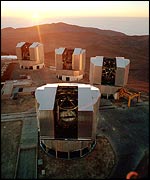Paranal Observatory
Paranal Observatory is the site of the European Southern Observatory's Very Large Telescope; it is located on the top of Cerro Paranal in the Atacama Desert in northern Chile in what is believed to be the driest area on Earth. Cerro Paranal is a 2,635-meter high mountain, about 120 kilometers south of the town of Antofagasta and 12 kilometers inland from the Pacific Coast. There is minimal light pollution, atmospheric conditions are unusually stable, humidity is virtually zero, and there are around 330 clear nights a year. The geographical coordinates are 24° 40' S, 70° 25' W.
Very Large Telescope
The Very Large Telescope (VLT) consists of four identical 8.2-meter telescopes, known as Antu ("Sun" in the language of Chile's indigenous Mapuche people), Kueyen (Moon), Melipal (Southern Cross), and Yepen (Venus), Paranal Observatory, which can work independently or together as the world's most powerful optical interferometer.
 |
The Very Large Telescope Interferometer (VLTI), equivalent to a single instrument with a mirror 16 meters in diameter, combines the light from the four big Unit Telescopes and from several moveable 1.8-meter Auxiliary Telescopes, spaced across baselines of up to 200 meters, by way of the Interferometric Tunnel. Inside this 130-meter-long underground cavern, the light beams gathered by the telescopes are passed through delay lines to compensate for the slightly different path-lengths they have taken in reaching the instruments. The delay lines help to synchronize the beams, before redirecting them to a central laboratory. The interference fringes produced when the beams are finally recombined provide the information needed to reconstruct the original image in unprecedented detail, giving a picture as sharp as if it had come from a single telescope 200 meters across. This gives the VLT a maximum angular resolution of about 0.001 arcsecond at 1 micrometer wavelength (in the near-infrared), which is equivalent to about 2 meters at the distance of the Moon. (The Moon has an angular diameter of 0.5° and a linear diameter of 3,476 kilometers; 0.5°/0.00 arcsecond = 1,800,000; 3,476 kilometers/1,800,000 ~ 2 meters). Used in interferometric as distint from individual-instrument mode, however, the VLT is only sensitive to objects with a high surface brightness, such as stars and the nuclei of active galaxies. This makes it unsuitable for observing most objects in the Solar System apart from the Sun.
In 2005, scientists using the VLT announced they had obtained the first direct photograph of an exoplanet – 2M1207b, which orbits the star 2M1207 more than 200 light-years away in the constellation Hydra.


